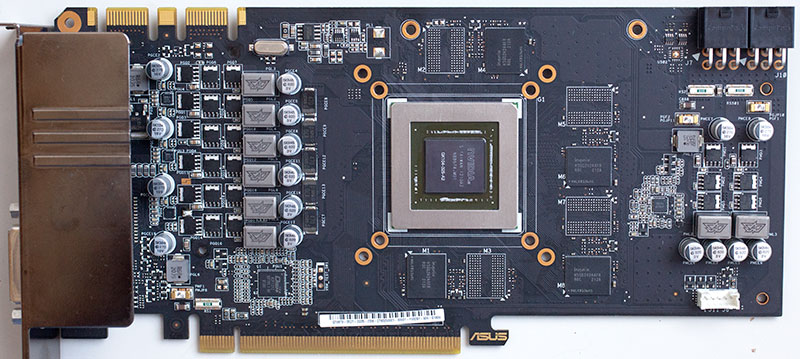What's the shortest 670 PCB design, by the way?
Zotac GTX670 DUAL KING D5 2GB:
Looks to be the size of the GTX670 PCB.
I agree that Reference 670 isn't a great design but non-reference GTX670s are built like tanks. There is nearly no reason at all to get a reference 670 or 680 for that matter imo when Zotac, Asus, Gigabyte are making such excellent cards.
Forget reference cards. After trying out the Sapphire Dual-X HD7970, I doubt I'll ever go back to reference blower design. The reduction in noise levels is unbelievable.
Zotac AMP! GTX670:
More pictures of this awesome card
here.
I can't think of a single high performing card that runs quieter than the Asus Direct CUII 670/680 series, not just recently,
EVER:
GTX670 Direct CUII under full load video
The previous generation high-end cards don't look particularly amazing in terms of build quality either:
7800GTX 256mb / 7800GS / 6800 GT
6800 Ultra at the bottom looks like the standout:
9700Pro and X800 Pro don't look anything special:
I think NV should have just reused the GTX680 PCB for the 670 version or used a higher quality fan/bearings and people wouldn't complain that much about the rattling noises it currently makes.
On the AMD side, the reference HD7970 is actually better than reference HD4870/4890 and is no worse than HD5870/6950/6970 cards. The difference is none of those 5870/6950/6970 cards could overclock 25-35%. HD5850 could but I am pretty sure at those levels its reference design also wasn't that quiet. Essentially the reference HD7970 blower design is overwhelmed by the extra power consumption that HD7970 itself draws over HD5870/6970. A lot of people here overclock 7970 to > 1125mhz and that causes the reference 7970 design to deal with way more power than it was designed to do. If HD5870 could overclock 25%, that reference design would also fail at quiet noise levels.
This is the most quality card, I have purchased.
What's so amazing about that card? It has no premium PCB, no solid state caps, no premium components of any kind. It looks like a reference designed 9600XT with a cheap Sapphire after market heatsink strapped on that pales in comparison to what Zalman used to make back in those days. 9600XT was also slow and was a fast card like GTX670 series is. I recall it was 40-50% slower than 9800Pro/XT. Is GTX670 40-50% slower than HD7970 / GTX680?
With modern cooling cases, for single-GPU card owners, I really don't see the point of buying a reference design card unless watercooling is involved (for full waterblocks). I heard all the negatives associated with dumping the hot air into the case for years which made me hesitant to purchase a non-reference card, but my HD7970 @ 1150mhz has not made any temperature differences in my case despite running at 99% load 24/7 for 3 days now. In fact, after switching from HD6950 @ 6970, my room is significantly colder. I am honestly confused because HD7970 is suposed to draw more power in overclocked states than my HD6950 @ 6970 speeds did.

From now on, I probably won't recommend blower type of cards for single-GPU users with decent cases. I don't even know why I waited this long to make the jump to after-market versions.
The
Tyan Tachyon 9700Pro was one of the best after market 9700 Pros at the time iirc:
How does that compare to today's after market cards? It's not even close.
Why in the world wouldn't someone pay $30 more for an
Asus Direct CUII that has a backplate for which EVGA charges $25 on Newegg I believe (Or $10 for Backplate cards?), has premium components and an after market cooler that's head and shoulders above most 670s:
Do you guys have really such poor airflow that your case cannot deal with 200-250W of heat dissipation? Hard to believe considering a lot of us were running Core i7 @ 4.0ghz and Q6600 @ 3.4ghz for years and at those speeds and voltages those CPUs alone were consuming as much as our modern GPUs. If you have a case with 2 front 120mm fans, a 1 rear exhausting 1x 120mm fan and a large 230mm fan at the top, that's all you need to deal with any high-end non-reference designed GPU. If you have a case with good airflow, a card dumping all the heat into the case should make almost no difference at all.
I think in this day and age the $20-30 premium over non-reference cards is almost a no brainer. You get better components, better coolers and quieter noise levels. The reduced noise levels alone are worth the premium.











